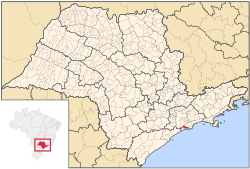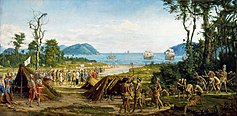São Vicente, São Paulo
- Machine translation, like DeepL or Google Translate, is a useful starting point for translations, but translators must revise errors as necessary and confirm that the translation is accurate, rather than simply copy-pasting machine-translated text into the English Wikipedia.
- Do not translate text that appears unreliable or low-quality. If possible, verify the text with references provided in the foreign-language article.
- You must provide copyright attribution in the edit summary accompanying your translation by providing an interlanguage link to the source of your translation. A model attribution edit summary is
Content in this edit is translated from the existing Portuguese Wikipedia article at [[:pt:São Vicente (São Paulo)]]; see its history for attribution. - You should also add the template
{{Translated|pt|São Vicente (São Paulo)}}to the talk page. - For more guidance, see Wikipedia:Translation.


Cellula-Mater of Nationality
Birthplace of Democracy in the Americas

 Brazil
Brazil São Paulo
São PauloSão Vicente (after Saint Vincent of Saragossa, the patron Saint of Lisbon, Portugal) is a coastal municipality in southern São Paulo, Brazil. It is part of the Metropolitan Region of Baixada Santista.[3] The population is 329,911 (2022 est.) in an area of 148,151 square kilometres (57,201.42 square miles).[1]
Founded in 1532, by the Portuguese explorer and colonial administrator Martim Afonso de Sousa, it is the first permanent village (colonial settlement) established in the Americas, and the first election on the American continent also took place there. Because of this, it is considered the "cradle of American democracy".[4]
São Vicente is one of the 15 municipalities in São Paulo considered seaside resorts by the state of São Paulo, as they meet certain prerequisites defined by State Law. This status guaranteed the municipality a larger budget from the State to promote regional tourism. Furthermore, the municipality acquires the right to add, next to its name, the title of "Estância Balneária" (Balneary Resort), a term by which it is designated both by official municipal records and by state references. Historical tourism and beach tourism are among the most relevant sectors of its economy.[5]
History

It was the first permanent Portuguese settlement in the Americas[6] and the first capital of the Captaincy of São Vicente, roughly the present state of São Paulo. Established as a proper village in 1532 by Martim Afonso de Sousa on what was then the Porto dos Escravos ("Port of the Slaves"), operated by three Portuguese colonists who trafficked on slaves captured by allied tribes, São Vicente is titled Cellula Mater (Mother Cell) of Brazil for being the first organized town in the country. The first City Council of all the Americas was democratically elected and established in São Vicente on August 22, 1532.[7]
A battle took place here on 3 February 1583 when three English warships attempting to trade with the Portuguese, was set upon by three Spanish galleons. The Spanish ships were repelled and retreated leaving one galleon sunk.[8]
Geography
São Vicente is located on the western half of coastal São Vicente Island, being mostly a bedroom community for the larger and wealthier neighbouring port and commercial city of Santos on the island's eastern half.[7] A small north–south hill range separates for the most part the two cities' urban areas, but they are contiguous in the north and on a narrow beach strip in the south. A narrow strip of land of the basin of the small Cubatão River extends west out of the central area of São Vicente, north and parallel to the municipality of Praia Grande.
São Vicente Suspension Bridge, linking the island to Praia Grande on the mainland, was constructed in 1914; a second link, the Mar Pequeno Bridge, was opened in 1981. São Vicente is linked to the capital city of São Paulo by the Imigrantes Highway and to the southern coast by the Manuel da Nóbrega Highway. São Vicente has a small fishing industry in its portion on the mainland, where there are a few small settlements.
Noted places
The Monument of 500 years of Brazil (Monumento dos 500 anos do Brasil) is a viewing platform on Porchat Island, an islet which extends from the south of São Vicente Island. The platform was designed by the architect Oscar Niemeyer (1907–2012). It faces roughly north in an imaginary line to the National Congress in Brasília, completed by Niemeyer and others in 1960.[9] The municipality contains part of the 901 hectares (2,230 acres) Xixová-Japuí State Park, created in 1993.[10]
Population history
| Year | Population |
|---|---|
| 2003 | 314,312 |
| 2004 | 321,474 |
| 2015 | 355,542 |
| 2022 | 329,911 |
Notable people
- Wlamir Marques, basketball player, Olympic medallist and World Champion
- Cosmo Alexandre, kickboxer and mixed martial artist
- Larissa Pimenta, judoka
- Jefferson, footballer
International relations
São Vicente is twinned with:
Bibliography
- "Do Litoral ao Planalto". História do Brasil: Área Vicentina.
- Lawrence, Rachel (January 2010). Alyse Dar (ed.). Brazil (Seventh ed.). Apa Publications GmbH & Co. / Discovery Channel. pp. 183–204.
References
- ^ a b "São Vicente (SP)". IBGE. Retrieved 2024-02-07.
- ^ "PNUD Brasil" (PDF).
- ^ "Lei Complementar nº 815, de 30 de julho de 1996". www.al.sp.gov.br (in Brazilian Portuguese). Retrieved 2023-08-22.
- ^ "Considerado o berço da democracia nas Américas, São Vicente completa 489 anos". Assembleia Legislativa de São Paulo (in Brazilian Portuguese). Retrieved 2024-02-07.
- ^ "Patrimônio: Lazer & Turismo - Revista Eletrônica - UNISANTOS". UniSantos. Retrieved 2024-02-07.
- ^ Rachel Lawrence: 2010, Page 183
- ^ a b Encyclopædia Britannica. Chicago, Ill.: Encyclopædia Britannica, Inc.
{{cite encyclopedia}}: Missing or empty|title=(help) - ^ Wilgus, Alva Curtis (1941). The Development of Hispanic America. Farrar & Rinehart, Incorporated. p. 181.
- ^ "São Vicente e Suas Atrações" (in Portuguese). Prefeitura Municipal de São Vicente. Retrieved 2016-06-28.
- ^ PES Xixová-Japuí (in Portuguese), ISA: Instituto Socioambiental, retrieved 2016-11-28
- ^ "姉妹・友好都市 | 平和・交流 | 自治・平和 | 那覇市". 2008-01-14. Archived from the original on 2008-01-14. Retrieved 2023-08-22.
External links

- (in Portuguese) São Vicente's official home page
- (in Portuguese) Portal Nosso São Paulo
- (in Portuguese) São Vicente São Paulo Brazil
- v
- t
- e
| Government | |
|---|---|
| Transport | |
| Education |
| Sports |
|
|---|
| |||||||||||||||||
- Espírito Santo
- Minas Gerais
- São Paulo
- Rio de Janeiro















